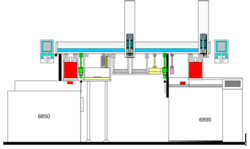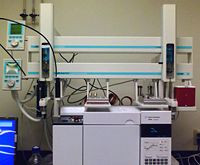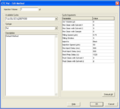Polymers
From LEAP

| Polymers |
| Application Type | |
| Sample Prep and Inject | |
| Application ID | |
| Sample | |
| Description | |
| Polymer Analysis |
Contents |
Overview
Chemical analysis of polymers, as well as other forms of analysis such as viscosity and other tests are a necessary part of polymer development, as well as QC processes during manufacture. Polymers are generally solids when in the final product, and thus are not amenable to such analysis unless they can be first liquefied. Preparation for analysis requires multiple stages of treatment frequently with heated reaction and cooling steps prior to introduction into a detector such as a GC. Such processes are lengthy, time-critical and labor intensive to perform manually. They frequently involve handling of caustic or toxic reagents. There is a strong case therefore, for automation of such processes.
LEAP has broken new ground in one such application, where the complexities of this type of sample preparation have been fully automated using an HTX2H in the configuration shown below:
Significant Markets
- Polymer Manufactures
- Biodiesel Blenders
- Polymer Distributors
- Polymer
ASTM Method D684
9. Calibration and Standardization
9.2 Standard Solutions – Prepare the five standard solutions in Table 3 by transferring the specified volumes by means of Microliter syringes to 10mL septa vials. Add to each of the five standard solutions 100uL of MSTFA. Close the vial and shake. Allow the vial to stand for 15 to 20 minutes at room temperature. Add approximately 8 mL n-Heptane to vial and shake.
| Standard Solution Number | 1 | 2 | 3 | 4 | 5 |
|---|---|---|---|---|---|
| uL of glycerin stock solution | 10 | 30 | 50 | 70 | 100 |
| uL of monoolein stock solution | 20 | 50 | 100 | 150 | 200 |
| uL of diolein stock solution | 10 | 20 | 40 | 70 | 100 |
| uL of triolein stock solution | 10 | 20 | 40 | 70 | 100 |
| uL of butanetriol stock solution | 100 | 100 | 100 | 100 | 100 |
| uL of tricaprin stock solution | 100 | 100 | 100 | 100 | 100 |
9.4 Standardization
9.5 Inject 1 uL of the reaction mixture into the cool-on-column injection port and start the analysis.
10. Procedure
10.1 Weigh to the nearest 0.1 mg approximately 100 mg of sample directly into a 10 mL septa vial. Using Microliter syringes, add exactly 100 uL of each internal standard and MSTFA. Shake the vials, and allow to set for 15 to 20 minutes at room temperature. Add approximately 8 mL of n-Heptane to vial and shake.
10.2 Inject 1 uL of the reaction mixture into the cool on-column injection port and start the analysis.
LEAP's Approach
The Lower PAL is the Prep PAL and runs on Cycle Composer Software. All of the sample prep is performed with this PAL. There is a 100ul syringe for the solvent transfers. There are (7) 2mL solvent locations. There is a DISPTool that is hooked up to a 5 mL dilutor syringe for the 8 mL Heptane addition. There is a fast wash station that Wash1 is filled with Toluene and Wash 2 is filled with Heptane. There is an agitator that is set at 35 deg C and 500RPM to do the mixing.
The Upper PAL is the Inject PAL and runs under ChemStation Software control. This requires Agilent CTC Control Software supplied by Agilent. It is using a 5 ul syringe with a tapered needle to do 1 ul on column injections into the rear injection port. There is a fast wash station that Wash1 is filled with Toluene and Wash 2 is filled with Heptane.
The expected Sample Prep Time is approximately 26 minutes
The expected GC Runtime is approximately 31.81 minutes
The expected GC Cool down time is approximately 7 minutes
Software Control
The Lower PAL is the Prep PAL and runs on Cycle Composer Software.
The Upper PAL is the Inject PAL and runs under ChemStation Software control.
Screenshots
Video
Useful links
Biodieselanalytical.com A good general reference site on Biodiesel automation theory and practice [1]
A good general reference site by Agilent [2]
UCONN.com A good general reference site on Biodiesel without buying the ASTM Methods [3]
Biodiesel Plant Listing [4]
Biodiesel Conference 2009 [5]








